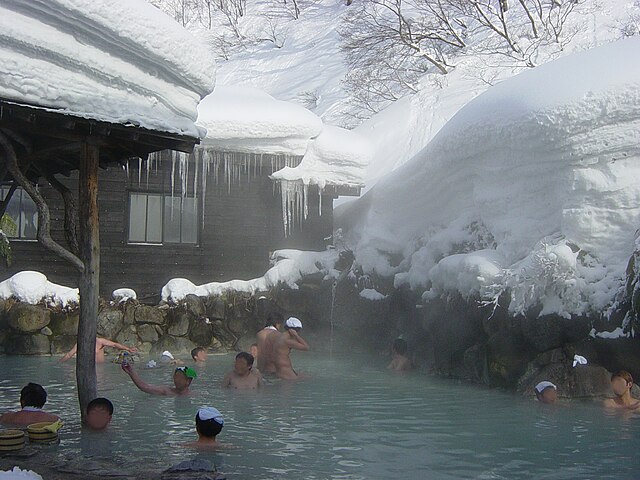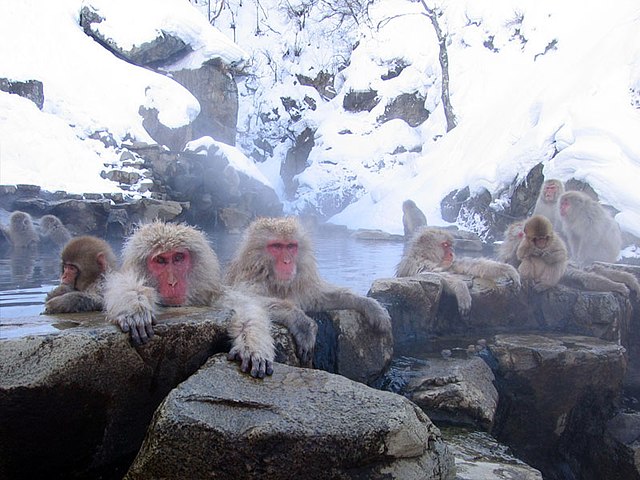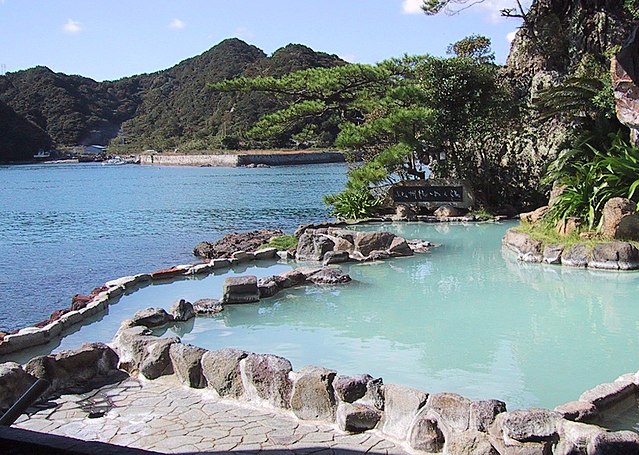Top Qs
Timeline
Chat
Perspective
List of hot springs in Japan
From Wikipedia, the free encyclopedia
Remove ads
This is a dynamic list of geothermal hot springs (onsen) as geological phenomena in Japan. This list is not for listing commercial establishments such as spa hotels, onsen ryokan, healing centers or other commercial establishments.



Japan has many geothermal spring systems as it is located in the Pacific Ring of Fire volcanic area. More than 27,000 hot spring sources exist in Japan,[1] together they discharge over 2.6 million liters of water every minute.[2]
These springs have played, and continue to play, an important role in Japanese culture throughout history.[3][4] In Shinto, Sukunabikona is the kami of the hot springs. As the deity of hot springs Sukunabikona and Ōkuninushi went to the Dōgo hot springs. There Ōkuninushi put Sukunabikona in the hot spring water to heal him of an ailment. Upon awakening, Sukunabikona danced atop a stone. It is said that his footprints left impressions on the rock, known as Tamanoishi, which still exists at Dogo Onsen north of the main building.[5][6]




Remove ads
Akita Prefecture


- Akinomiya Hot Springs
- Nyūtō Onsen
- Ōfuka Onsen
- Takanoyu Onsen also known as Falcon's Hot Spring
- Tamagawa Hot Spring is tied (with Higashi Onsen in Kagoshima) for the highest acid content of all hot springs in Japan, at a PH value of 1.2.[1]
- Tsurunoyu Onsen
Aomori Prefecture
- Asamushi Onsen
- Furofushi Onsen
- Kappa-no-you Hot Spring
- Oku-yagen Hot Spring
- Sukayu Onsen
- Yagen Onsen
Ehime Prefecture
- Dōgo Onsen was mentioned in the oldest collection of Japanese poetry, the Man’yo Wakashu.[1]
Fukui Prefecture
Fukushima Prefecture
Gifu Prefecture
- Gero Onsen, Gero, Gifu, Hida River
- Hirayu Onsen, Takayama
- Nagaragawa Onsen
Gunma Prefecture


- Akagi, Gunma
- Ikaho Onsen, Ikaho, a.k.a. Ikaho Onsen, Kogane-no-Yu (The Golden Waters), Kodakara-no-Yu (Child Waters)
- Kusatsu Onsen
- Sawatari Hot Springs
- Rosoku Onsen has the highest radium content in all of Japan.,[1] also known as Yunoshima Radium Kosen Hoyojo (Rosoku Onsen) (有限会社 湯之島ラジウム鉱泉保養所)[7]
- Shima Onsen
- Takaragawa Onsen
Hokkaido Prefecture
Hokkaido Prefecture has the third most hot springs with 2,304 registered. The hot springs in the prefecture have the second highest discharge rate of water at 260 kiloliters per minute.[1]
- Asahidake Onsen
- Futamata
- Jōzankei Onsen
- Kamuiwakka Falls
- Noboribetsu Jigokudani, or Hell Valley, the main source of the Noboribetsu onsen
- Onneyu Onsen
- Onnetō Hot Falls
- Sōunkyo Onsen
- Tenninkyo Onsen
- Tōyako, Hokkaidō, Shikotsu-Toya National Park
- Yunokawa Onsen
Remove ads
Hyōgo Prefecture

- Arima Onsen, Kobe, was mentioned in the Nihon Shoki, the second oldest account of the history of Japan (after the history presented in Kojiki)[1]
- Kinosaki, Hyōgo
- Takarazuka, Hyōgo
- Yumura Onsen, (Shin'onsen, Hyōgo) Yumura Onsen has the hottest water in Japan with a temperature of 208.4 degrees Fahrenheit (98 degrees Celsius).[1]
Ishikawa Prefecture
- Awazu Onsen, Komatsu, Ishikawa
- Katayamazu Onsen, Kaga, Ishikawa
- Wakura Onsen, Nanao
- Yamanaka Onsen, Kaga
- Yamashiro Onsen, Kaga
- Yuwaku Onsen
Iwate Prefecture
Kagawa Prefecture
Kanagawa Prefecture
- Hakone, Kanagawa, near Tokyo. See also Ōwakudani
- Iiyama Onsen and one other hot spring (Tokigawa Onsen in Saitama Prefecture) are tied for the highest alkalinity in all of Japan.[1]
- Miyanoshita Onsen
- Tsurumaki Onsen Tsurumaki Onsen has the highest calcium content in its waters of all the hot springs in Japan.[1]
- Yugawara
Kagoshima Prefecture
Kagoshima prefecture has the second most hot springs in Japan, with 2,824 registered.[1] The hot springs systems in Kagoshima have the third highest discharge rate at 201 kiloliters per minute.[1]
- Higashi Onsen and one other hot spring (Tamagawa Onsen in Akita) have the highest acidity content in its water at a PH value of 1.2, of all the hot springs in Japan.[1]
- Ibusuki Onsen
- Kirishima
Kyoto Prefecture
Kumamoto Prefecture

- Aso, Kumamoto, Mount Aso
- Kurokawa Onsen, Aso[8]
- Nuruyu Onsen
Mie Prefecture
Miyagi Prefecture
Nagano Prefecture

- Asama Onsen
- Honzawa Onsen has the highest elevation for an open-air onsen, at 2,150 meters.[1]
- Jigokudani
- Kakeyu Onsen
- Nozawaonsen
- Shibu
- Suwa
- Yudanaka Onsen
Nagasaki Prefecture

- Obama Onsen supposedly the hottest Japanese hot spring (105 °C or 221 °F)
- Shimabara, Nagasaki
- Unzen Onsen
Niigata Prefecture
- Iwamuro, Niigata
- Senami Onsen
- Tsubame Onsen
- Tsukioka Onsen, Niigata
- Yuzawa, Niigata
Okayama Prefecture
- Yubara Onsen, Okayama Prefecture at the foot of Yubara dam
- Yunogo Onsen, Okayama Prefecture
Ōita Prefecture


Oita is the prefecture with the most geothermal spring sources in Japan, 4,788 are registered. The prefecture also has the highest discharge rate of 296 kiloliters per minute[1]
- Beppu Onsen, Hells of Beppu, Beppu, Ōita Prefecture
- Hyotan Onsen
- Kankaiji Onsen
- Myoban Yunosato Onsen
- Nagayu Onsen has the highest level of carbon dioxide of any hot spring in the world.[1]
- Takegawara Onsen
- Yufuin, Ōita Prefecture
Saga Prefecture
Saitama Prefecture
- Tokigawa Onsen and one other hot spring (Iiyama Onsen in Kanagawa Prefecture) are tied for first place for the highest alkalinity in the water.[1]
Shimane Prefecture
- Tamatsukuri Onsen is mentioned in the Izumo no Kuni Fudoki (Chronicle of the Land of Izumo) from the year, 733.[2]
Shizuoka Prefecture

- Atami Onsen, Atami
- Hokkawa Onsen
- Itō, Shizuoka
- Kanzanji Onsen
- Minami-Alps Akaishi Onsen Shirakaba-so
- Mine Onsen, Daifunto Park Kawazu town. (Dai funto park) Kawazu, Shizuoka
- Shuzenji Onsen
- Sumatakyō Onsen
Tochigi Prefecture
- Kinugawa Onsen, Tochigi
- Shiobara Onsen
Tottori Prefecture
- Hawai Onsen
- Kaike Onsen, Yonago, Tottori
- Misasa Onsen, Misasa
- Tōgō Onsen
Toyama Prefecture
- Mikuriga-ike Onsen has the highest elevation of all hot springs in Japan, with an elevation of 2,400 meters.[1]
- Unazuki Onsen, Kurobe
Wakayama Prefecture

- Kawayu Onsen, Tanabe, Wakayama
- Nanki-Katsuura Onsen, Nachikatsuura, Wakayama
- Nanki-Shirahama Onsen, Shirahama
- Ryujin Onsen, Tanabe, Wakayama
- Tsubaki Onsen
- Yunomine Onsen, Tanabe, Wakayama, site of the UNESCO World Heritage Tsuboyu bath
Yamagata Prefecture
- Akayu, Yamagata
- Ginzan Onsen, Obanazawa
- Zaō Onsen
Yamanashi Prefecture
- Shimobe Onsen
Other locations
- Kaniyu Onsen
- Okukinu hot springs group
- Sashiusudake [Baransky] hot springs - in disputed territory between Japan & Russia
See also
References
Further reading
External links
Wikiwand - on
Seamless Wikipedia browsing. On steroids.
Remove ads
